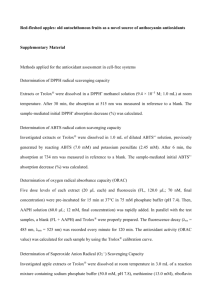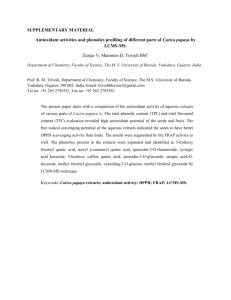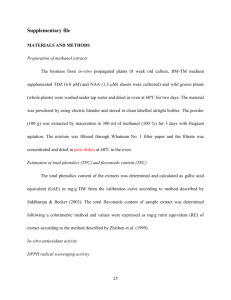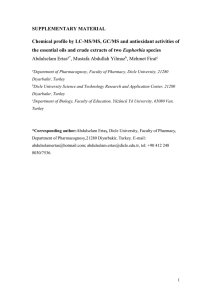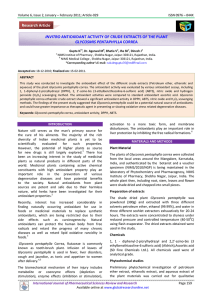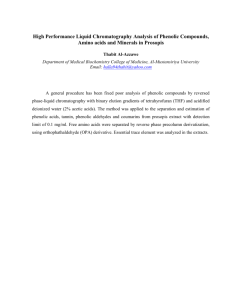Document 13310093
advertisement
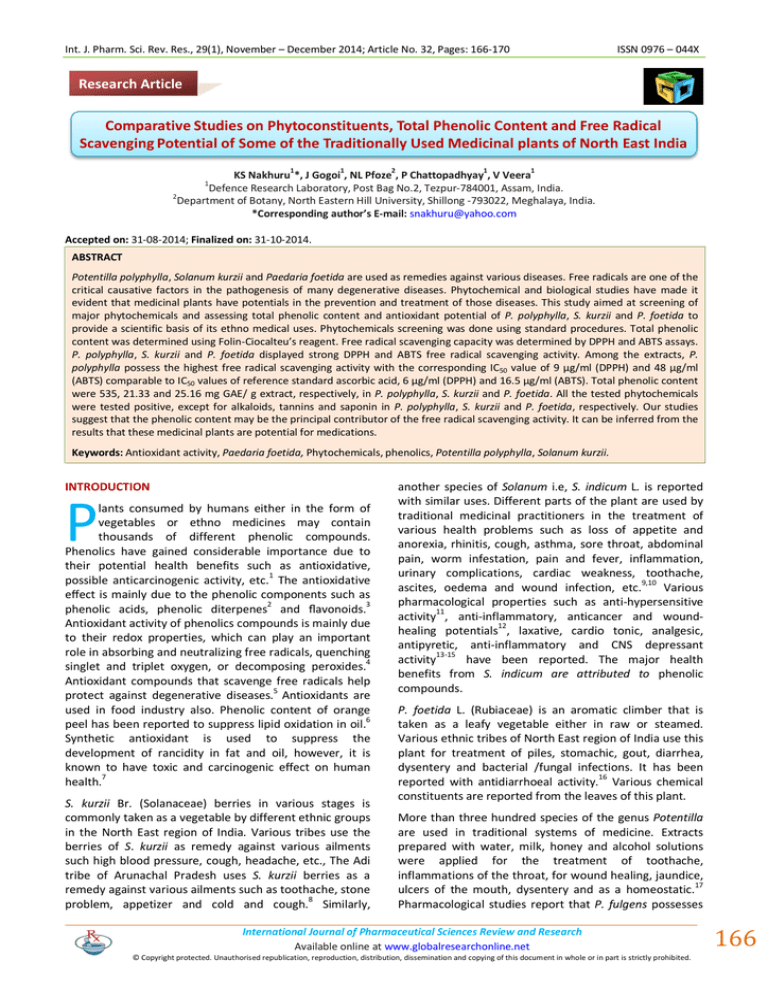
Int. J. Pharm. Sci. Rev. Res., 29(1), November – December 2014; Article No. 32, Pages: 166-170 ISSN 0976 – 044X Research Article Comparative Studies on Phytoconstituents, Total Phenolic Content and Free Radical Scavenging Potential of Some of the Traditionally Used Medicinal plants of North East India 1 1 2 1 1 KS Nakhuru *, J Gogoi , NL Pfoze , P Chattopadhyay , V Veera Defence Research Laboratory, Post Bag No.2, Tezpur-784001, Assam, India. 2 Department of Botany, North Eastern Hill University, Shillong -793022, Meghalaya, India. *Corresponding author’s E-mail: snakhuru@yahoo.com 1 Accepted on: 31-08-2014; Finalized on: 31-10-2014. ABSTRACT Potentilla polyphylla, Solanum kurzii and Paedaria foetida are used as remedies against various diseases. Free radicals are one of the critical causative factors in the pathogenesis of many degenerative diseases. Phytochemical and biological studies have made it evident that medicinal plants have potentials in the prevention and treatment of those diseases. This study aimed at screening of major phytochemicals and assessing total phenolic content and antioxidant potential of P. polyphylla, S. kurzii and P. foetida to provide a scientific basis of its ethno medical uses. Phytochemicals screening was done using standard procedures. Total phenolic content was determined using Folin-Ciocalteu’s reagent. Free radical scavenging capacity was determined by DPPH and ABTS assays. P. polyphylla, S. kurzii and P. foetida displayed strong DPPH and ABTS free radical scavenging activity. Among the extracts, P. polyphylla possess the highest free radical scavenging activity with the corresponding IC50 value of 9 µg/ml (DPPH) and 48 µg/ml (ABTS) comparable to IC50 values of reference standard ascorbic acid, 6 µg/ml (DPPH) and 16.5 µg/ml (ABTS). Total phenolic content were 535, 21.33 and 25.16 mg GAE/ g extract, respectively, in P. polyphylla, S. kurzii and P. foetida. All the tested phytochemicals were tested positive, except for alkaloids, tannins and saponin in P. polyphylla, S. kurzii and P. foetida, respectively. Our studies suggest that the phenolic content may be the principal contributor of the free radical scavenging activity. It can be inferred from the results that these medicinal plants are potential for medications. Keywords: Antioxidant activity, Paedaria foetida, Phytochemicals, phenolics, Potentilla polyphylla, Solanum kurzii. INTRODUCTION P lants consumed by humans either in the form of vegetables or ethno medicines may contain thousands of different phenolic compounds. Phenolics have gained considerable importance due to their potential health benefits such as antioxidative, possible anticarcinogenic activity, etc.1 The antioxidative effect is mainly due to the phenolic components such as 2 3 phenolic acids, phenolic diterpenes and flavonoids. Antioxidant activity of phenolics compounds is mainly due to their redox properties, which can play an important role in absorbing and neutralizing free radicals, quenching singlet and triplet oxygen, or decomposing peroxides.4 Antioxidant compounds that scavenge free radicals help protect against degenerative diseases.5 Antioxidants are used in food industry also. Phenolic content of orange 6 peel has been reported to suppress lipid oxidation in oil. Synthetic antioxidant is used to suppress the development of rancidity in fat and oil, however, it is known to have toxic and carcinogenic effect on human 7 health. S. kurzii Br. (Solanaceae) berries in various stages is commonly taken as a vegetable by different ethnic groups in the North East region of India. Various tribes use the berries of S. kurzii as remedy against various ailments such high blood pressure, cough, headache, etc., The Adi tribe of Arunachal Pradesh uses S. kurzii berries as a remedy against various ailments such as toothache, stone problem, appetizer and cold and cough.8 Similarly, another species of Solanum i.e, S. indicum L. is reported with similar uses. Different parts of the plant are used by traditional medicinal practitioners in the treatment of various health problems such as loss of appetite and anorexia, rhinitis, cough, asthma, sore throat, abdominal pain, worm infestation, pain and fever, inflammation, urinary complications, cardiac weakness, toothache, ascites, oedema and wound infection, etc.9,10 Various pharmacological properties such as anti-hypersensitive 11 activity , anti-inflammatory, anticancer and wound12 healing potentials , laxative, cardio tonic, analgesic, antipyretic, anti-inflammatory and CNS depressant activity13-15 have been reported. The major health benefits from S. indicum are attributed to phenolic compounds. P. foetida L. (Rubiaceae) is an aromatic climber that is taken as a leafy vegetable either in raw or steamed. Various ethnic tribes of North East region of India use this plant for treatment of piles, stomachic, gout, diarrhea, dysentery and bacterial /fungal infections. It has been 16 reported with antidiarrhoeal activity. Various chemical constituents are reported from the leaves of this plant. More than three hundred species of the genus Potentilla are used in traditional systems of medicine. Extracts prepared with water, milk, honey and alcohol solutions were applied for the treatment of toothache, inflammations of the throat, for wound healing, jaundice, ulcers of the mouth, dysentery and as a homeostatic.17 Pharmacological studies report that P. fulgens possesses International Journal of Pharmaceutical Sciences Review and Research Available online at www.globalresearchonline.net © Copyright protected. Unauthorised republication, reproduction, distribution, dissemination and copying of this document in whole or in part is strictly prohibited. 166 © Copyright pro Int. J. Pharm. Sci. Rev. Res., 29(1), November – December 2014; Article No. 32, Pages: 166-170 anti-hyperglycemic, anti-hyperlipidemic, antitumor, antioxidant, anti-inflammatory and antiulcerogenic properties. Active principle with anti-hyperglycemic, antihyperlipidemic and antioxidant effects have been identified as trans-tiliroside from one of the Potentilla species i.e., P. chinesis.18 Ethnic tribes of North East region of India such as Poumai, Mao and Kuki use P. polyphylla Wall.ex Lehm. (Rosaceae) as a remedy against burns and/or cuts and wounds, toothache, diabetes, etc. The present study aimed to evaluate the phytochemical constituents, total phenolic content and free radical scavenging capacities of P. polyphylla, S. kurzii and P. foetida extracts so as to explore the potential of these herbs as new source of natural antioxidants for pharmaceutical and/or neutraceutical applications. MATERIALS AND METHODS Chemicals 2, 2-Diphenyl-1-picrylhydrazyl (DPPH), 2, 2′-Azino-bis (3ethylbenzothiazoline 6-sulfonic acid (ABTS), Ascorbic acid, Gallic acid were from Sigma-Aldrich (St. Louis, USA). All other chemicals or reagents were of analytical grade from Himedia, Merck – Mumbai, India. Plant material Fresh plants of P. polyphylla Wall. ex Lehm. were obtained from Iewduh (Bara Bazar), Shillong, Meghalaya, India. S. kurzii Br. and P. foetida L. collected from home garden and herbal garden, respectively, at Defence Research Laboratory, Tezpur (91° 48'E and 26° 38'N), Assam, India. Voucher specimens were identified with the help of Botanical Survey of India, Shillong (No.BSI/ERC/2010/Plant identification/477) and Department of Botany, North Eastern Hill University, Shillong.19 Extraction Aqueous methanol (1:4) was used as the extraction solvent for shade-dried, powdered samples of P. polyphylla roots, berries of S. kurzii and twigs and leaves of P. foetida.20 Extracts were stored at -20°C till further analyses. Phytochemical screening Phytochemicals were screened following commonly used standard procedures. Total phenol content determination The total phenol content of the extract was determined by using Folin-ciocalteu reagent according to the procedure described.21 Briefly, 0.5 ml of plant extract was added to 0.1 ml of Folin-Ciocalteu’s reagent (0.5 N) and mixed thoroughly and incubated at room temperature. 2.5 ml of sodium carbonate solution (2 M) was added after 10-12 min and further incubated for another 30 min. The absorbance was measured spectrophotometrically at 760 nm (Thermo UV 1), against a blank. Gallic acid was ISSN 0976 – 044X used as reference standard. Total phenol content is expressed in term of Gallic acid equivalent (mg/g dry weight of the extract). The test was performed in triplicates. Free radical scavenging activity Radical scavenging capacity was assessed by DPPH and ABTS radical scavenging assays. DPPH radical scavenging assay DPPH radical is measured by a UV spectrophotometer at 517 nm using the method described by Brand-Williams et al.22 Briefly, 2 ml of sample and standard at different concentrations (5–50 µg/ml) was added to 1ml of 0.002% of DPPH in ethanol. The mixture was shaken vigorously and incubated in the dark for 30 min at room temperature. Absorbance (Abs sample) was read at 517 nm (Thermo UV 1) against blank solution (Abs blank) which contained 3 ml of ethanol. A solution containing 2 ml of DPPH and 1 ml of ethanol was used as a control (Abs control). Ascorbic acid was used as reference standard. Lower absorbance indicated higher radical scavenging activity. The radical scavenging potential is expressed as IC50. IC50 values were the effective concentrations at which DPPH radicals were scavenged by 50%. DPPH radical scavenging activity was calculated as: DPPH radical scavenged (%) = [(Abs control ‐ Abs sample) /Abs control] × 100 The test was carried out in triplicates. ABTS radical scavenging assay ABTS (2 mM) and potassium persulphate (970 mM) were prepared in distilled water. 200 µl of potassium persulfate and 50 µl of ABTS were mixed and used after 2 h. This preformed ABTS radical cation in the solution was assayed according to Shirwaikar et al.23 To 500 µl of various concentrations (5–50 µg/ml) of plant extract and reference standard, 300 µl of ABTS radical cation and 1.7 ml phosphate buffer 7.4 were added. For the control methanol was used, instead of extract. The absorbance was measured at 743 nm. Ascorbic acid was used as reference standard. The experiment was performed in triplicates. Radical scavenging activity was calculated as: ABTS radical scavenged (%) = [(Abs control ‐ Abs sample) / Abs control] × 100 RESULTS Qualitative screening of the plant extracts is summarized in Table 1 and their total phenolic contents are represented in Figure 1 which is expressed in mg GAE/g dry weight of extract. Radical scavenging activities of the extracts and reference standard ascorbic acid in term of IC50 are given in Table 2. Figure 2 & 3 represent percentage inhibition of DPPH and ABTS radicals by extracts and ascorbic acid at 50 µg ml-1 each. International Journal of Pharmaceutical Sciences Review and Research Available online at www.globalresearchonline.net © Copyright protected. Unauthorised republication, reproduction, distribution, dissemination and copying of this document in whole or in part is strictly prohibited. 167 © Copyright pro Int. J. Pharm. Sci. Rev. Res., 29(1), November – December 2014; Article No. 32, Pages: 166-170 ISSN 0976 – 044X Table 1: Phytochemical screening in aqueous methanolic extracts P. polyphylla, P. foetida and S. kurzii Phytochemicals P. polyphylla S. kurzii P. foetida Test Flavonoids + + + HCl and Mg ribbon Tannins + - + 5% FeCl3 Terpenoids + + + Keller-Keliani Alkaloids - + + Dragendrorff’s reagents Steroids + + + Liebermann-Buchard Saponins + + - Frothing in aqueous + + + Salkowski Cardiac glycosides Key: +: present; -: absent Figure 1: Total phenolic content of the extracts of P. polyphylla (Pp), S. kurzii (Sk) and P. foetida (Pf). Values are represented as an average of triplicate ±SD in mg Gallic acid equivalent g-1 dry weight of extract. Figure 3: ABTS radical scavenging activity of extracts and ascorbic acid (50 µg/ml). Values are represented as an average of triplicate ±S D. AA: Ascorbic acid, PP: P. polyphylla, SK: S. kurzii and PF: P. foetida. Table 2: In vitro antioxidant activity of ascorbic acid, P. polyphylla, S. kurzii and P. foetida DISCUSSION Plants/Reference standard IC50 values (µg/ml) DPPH ABTS P. polyphylla 9 48 S. kurzii 271 315 P.foetida 260 180 Ascorbic acid 6.5 16.5 Values are expressed as an average of triplicate. Figure 2: DPPH radical scavenging activity of extracts and ascobic acid (50 µg/ml). Values are represented as an average of triplicate ± S.D. AA: Ascorbic acid, PP: P. polyphylla, SK: S kurzii and PF: P.foetida. Stress related diseases are increasing day by day and therefore the need for antioxidants are ever increasing. The present study was taken up to assess its major phytoconstituents, total phenolic content and free radical scavenging effect for sourcing potential source of natural antioxidants. Present investigation revealed the presence of terpenoids, steroids, tannins, flavonoids, saponins and cardiac glycosides in table 1. Trans-tiliroside, triterpenes and flavones have been reported in P. chinesis, one of the Potentilla species. The presence of antioxidant compounds epicatechin and a new bioflavonoid (Potifulgene) are reported in P. fulgens species.24 The presence of flavonoids, steroids, saponins, anthraquinones, reducing sugars, tannins are reported but not alkaloids from the berries of S. indicum.14 However, alkaloids were detected in another study.10 Presences of flavonoids, terpenoids, steroids, saponins, alkaloids, cardiac glycosides were detected, except for tannins, during our investigation in the berries of S. kurzii. The qualitative tests confirmed the presence of alkaloids, tannins, saponins, terpenoids, flavonoids and phenol and absence of cardiac glycosides and steroids in aqueous 25 extract of P. foetida. Saponins were tested negative in our investigation, however cardiac glycosides and steroids 25 were detected in contrast with the report of Upadhyay. Phenolic compounds are widely distributed in plants which have gained much attention due to their biological activities such as antimutagenic, antitumor, antioxidant International Journal of Pharmaceutical Sciences Review and Research Available online at www.globalresearchonline.net © Copyright protected. Unauthorised republication, reproduction, distribution, dissemination and copying of this document in whole or in part is strictly prohibited. 168 © Copyright pro Int. J. Pharm. Sci. Rev. Res., 29(1), November – December 2014; Article No. 32, Pages: 166-170 activity, free radical scavenging ability, etc, which have beneficial implications for human health.26 Total polyphenol content was measured with the use of FolinCiocalteu phenol reagent. Phenolic content ranged between 21.33-535 mg GAE /g extract in Figure 1. P. polyphylla showed the highest phenolic content followed by P. foetida and S. kurzii. Phenolic content of P. polyphylla we report here is comparable with the report of Syiem et al in P. fulgens.27 S. indicum from Iran was 28 reported with the phenolic content of 7.02 mg GAE/g dry material. A very high phenolic content of 28.33 mg frulic acid equivalent/g dry sample (leaves and twigs) and 14.60 mg GAE/g dry sample were reported from Malaysia29 and Arunachal Pradesh,8 respectively, in contrast to our report. The difference might be due to difference in growing conditions. Polyphenols are characterized by high antiradical potential. Phenolic 30 antioxidants are potent free radical terminator. Free radical scavengers may directly react with and quench peroxide radicals to terminate the peroxidation chain reaction.31 Assays based on the use of DPPH and ABTS radicals are widely used for determination of antioxidant capacity of food, beverages and vegetables extracts. These assays are rapid, sensitive and reproducible.32,33 DPPH radical, after accepting electron or hydrogen, is converted into stable DPPH-H form. When this conversion occurs, deep violet colour of DPPH turns into light yellow colour. Unconverted stable DPPH radical is measured by UV spectrophotometer at 517 nm. DPPH and ABTS radicals scavenging potentials of the extracts and ascorbic acid are represented by their corresponding IC50 values in Table 2. Figure 1 & 2 represent percent inhibition of DPPH and ABTS radicals by extracts and ascorbic acid at the concentration of 50 µg ml-1. Strong radical scavenging activity was expected in P. polyphylla since antioxidant activity increases proportionally with the phenolic content.34,1 The phenolic compounds are the main agents that can donate hydrogen to free radicals and thus break the chain reaction of lipid oxidation at the first initiation step. This high potential of phenolic compounds to scavenge radicals may be explained by their phenolic 35 hydroxyl groups. IC50 value of P. polyphylla extract (9 µg /ml) was comparable to IC50 value of reference standard ascorbic acid (6 µg/ml) by DPPH assay. Similarly, IC50 value of extract (46 µg/ml) was comparable to IC50 value of reference standard ascorbic acid (16.5 µg/ml), by ABTS assay. The DPPH radical scavenging activity of the extract may be attributed due to the presence of hydrogen‐donating ability of OH and –CH3 group in the 36,37 crude extract. Free radical scavenging capacity of S. kurzii extract was low when compared to reference standard with the corresponding IC50 values of 271 µg/ml (DPPH) and 315 µg/ml (ABTS). Similarly, P. foetida exhibited IC50 values of 260 µg/ml (DPPH) and 180 µg/ml (ABTS). Thus P. polyphylla demonstrated better radical scavenging ability than the other two samples. Therefore the radical scavenging ability of the extracts could be attributed to the higher phenolic compounds and to some extend due to the presence of other phytoconstituents ISSN 0976 – 044X such as steroids, terpenoids, etc., detected in the plant extracts. CONCLUSION Our studies suggest that phenolic content may be the principal contributor of the free radical scavenging activity. High phenolic content and free radical or antioxidant capacity of P. polyphylla, P. foetida and S. kurzii may imply the possible inhibition of cellular oxidants that is linked to the pathological incidents of various degenerative diseases. However, the components responsible for the free radical scavenging or antioxidant effect of the plant extracts are unclear. Therefore, it is suggested that further work could be undertaken on the isolation and identification of anti-oxidative components from the extracts to explore the possible source of natural antioxidant for pharmaceutical, neutraceutical or even food preservative applications. Further, this study proved useful for selecting the better source of natural antioxidants among these three plants which can be extended for comparison with other species or same species belonging to different regions with different climatic conditions. REFERENCES 1. Malenčić D, Popović M, Miladinović J, Phenolic content and antioxidant properties of soybean (Glycine max L.) Merr. Seeds, Molecules, 12, 2007, 576-581. 2. Shahidi F, Janitha P K, Wanasundara PD, Phenolic antioxidants, Critical Reviews of Food Science & Nutrition, 32 (1), 1992, 67–103. 3. Pietta PG, Flavonoids in medicinal plants, In CA Rice Evans & L Packer (Eds.), Flavonoids in health and disease, New York, Dekker, 1998, 61–110. 4. Osawa T, Novel natural antioxidants for utilization in food and biological systems, In I. Uritani, V V Garcia & E M, Mendoza (Eds.), Postharvest biochemistry of plant foodmaterials in the tropics (pp.), Tokyo, Japan: Japan Scientific Societies Press, 1994, 241–251. 5. Amin I, Tan SH, Antioxidant activity of selected commercial seaweeds, Malaysia Journal of Nutrition, 8, 2002, 167-177. 6. HA Abd El-aal FT Halaweish, Food Preservative Activity of Phenolic Compounds in Orange Peel, Lucrări Ştiinţifice, 53, 457-464. http://www.univagroiasi.ro/revista_zoo/index.php?lang+e n&pagina=archieve.html. 7. Rehman ZU, Citrus peel extract – A natural source of antioxidant, Food Chemistry, 99, 2006, 450-454. 8. Payum T, Das AK, Tumly C, Shanker R, Hazarika M, Antioxidant potential of Solanum kurzii Berry: A Folk Medicinal Food Berry Used in Arunachal Pradesh, NorthEast India, Global Journal of Medical Research, 13 (6), 2013, 1-6. 9. Bhakta T, Common Vegetables of the Tribals of Tripura. Agartala, Tripura, India: Tripura Tribal digestion Solanum indicum L. concentrated solution, Clinical Toxicology, 46 (4), 2004, 293–96. International Journal of Pharmaceutical Sciences Review and Research Available online at www.globalresearchonline.net © Copyright protected. Unauthorised republication, reproduction, distribution, dissemination and copying of this document in whole or in part is strictly prohibited. 169 © Copyright pro Int. J. Pharm. Sci. Rev. Res., 29(1), November – December 2014; Article No. 32, Pages: 166-170 10. Bhattacharya AS, Chiranjivi Banaushadhi, 2nd volume, 3rd reprint, Kolkata, Ananda Publishers, 1982. 11. Bahgat A, Abdel A, Raafat M, Mahdy A, EL khatib A, Ismail A, Khayyal M, “Solanum indicum ssp. distichum extract is effective against L-NAME induced hypertension in rats”, Fundamental clinical pharmacology, 22 (6), 2008, 693-99. 12. Ma P, Cao TT, Gu GF, Zhao X, Du YG, Zhang Y, “Inducement effect of synthetic indiosides from Solanum indicum L. on apoptosis of human hepatocarcinoma cell line Bel-7402 and its mechanism”, Chinese Journal of Cancer, 25(4), 2006, 438-42. 13. Deb PK, Das N, Bhakta RG, Evaluation of In-vitro Antioxidant and Anthelmintic Activity of Solanum indicum Linn. Berries, Indo American Journal of Pharmaceutical Research, 3 (2), 2013, 4123-4130. 14. Deb PK, Das L, Ghosh R, Debnath R, Bhakta T, Evaluation of laxative and cardio tonic activity of solanum indicum Linn. Fruits, Pharmaceutical Phytotherapy, 1(3), 2013, 11–14. 15. Deb PK, Ghosh, R, Chakraverty R, Debnath R, Das L, Bhakta T, Phytochemical and Pharmacological Evaluation of Fruits of Solanum indicum Linn., International Journal Pharmaceutical Sciences Review Research, 25 (2), 2014, 2832. 16. Afroz S, Alamgir M, Khan MTH, Jabbar S, Nahar N, Choudhuria MSK, Antidiarrhoeal activity of the ethanol extract of Paederia foetida Linn. (Rubiaceae), Journal of Enthnopharmacology, 105, 2006, 125-130. 17. Fuchs L, New Kreüterbuch, Baesel Kapital 98, (Von Tormenill), 1543. 18. Qiao W, Zhao C, Qin N, Identification of trans-tiliroside as active principle with anti-hyperglycemic, antihyperlipedemic and antioxidant effects from Potentilla chinesis, 2010. http://www.paper.edu.cn/en_releasepaper/content/43992 96 19. Pfoze NL, Kumar Y, Myrboh B, Survey and assessment of ethnomedicinal plants of Senapati District of Manipur state, Northeast India, Phytopharmacology, 2(2), 2012, 285–31. 20. Harborne JB, Phytochemical Methods, 3rd Ed, London: Chapman and Hall, 1998. 21. McDonald S, Prenzler PD, Antolovich M, Robards K, Phenolic content and antioxidant activity of olive extracts, Food Chemistry, 73, 2001, 73 – 84. 22. Brand‐Williams W, Cuvelier, ME, Berset C, Use of a free radical method to evaluate antioxidant activity, LWT ‐ Food Science Technology, 28 (1), 1995, 25‐30. 23. Shirwaikar A, Shiwaikar A, Rajendran K, Punitha ISJ, In vitro antioxidant studies on the benzyl tetra isoquinoline alkaloid berberine, Biological Pharmacology Bulletien, 29, 2006, 1906‐1910. ISSN 0976 – 044X 24. Jaitak V, Sharma K, Kalia K, Antioxidant activity of Potentilla fulgens: An alpine plant of western Himalayas, Journal Food Composition Analysis, 23, 2010, 142–147. 25. Upadhaya S, Screening of phytochemicals, nutritional status, antioxidant and antimicrobial activity of paedaria foetida Linn. from different localities of Assam, India, Journal of pharmacy research, 7(1), 2013, 139-141. 26. Li YF, Guo CJ, Yang JJ, Wei JY, Xu J, Cheng S, Evaluation of antioxidant properties of pomegranate pulp extract, Food Chemistry, 96, 2006, 254-260. 27. Syiem D, Sharma R, Saio V, In vitro study of the antioxidant potential of some traditionally used medicinal plants of North-East India and assessment of their total phenolic content, Pharmacologyonline, 3, 2009, 952-965. 28. Ali Aberoumand, Deokule SS, Total phenolic content of some plant foods as an antioxidant compound, Journal of food Technology, 8 (3), 2010, 131-133. 29. Osman H, Rahim AA, Isa NM, Nornaemah M, Bakhir NM, Antioxidant Activity and Phenolic Content of Paederia foetida and Syzygium aqueum, Molecules, 14, 2009, 970978. 30. Shahidi F, Wanasundara PKJPD, Phenolic antioxidants, Critical Review in Food Science and Nutrition, 32, 1992, 67103. 31. Soares JR, Dins TCP, Cunha AP, Ameida LM, Antioxidant activity of some extracts of Thymus zygis, Free Radical Research, 26, 1997, 469‐478. 32. Bendini A, Cerretani L, Pizzolante L, Toschi TG, Guzzo F, Ceoldo S, Marconi AM, Andrectta F, Levi M, Phenol content related to the antioxidant and antimicrobial activities of Passiflora spp. Extracts, European Food Research Technology, 223, 2006, 102‐109. 33. Gramza-Michalowska A, Antiradical Methods in Evaluating Antioxidant Potential of Preparations of Plant Origin, Medicinal Aromatic Plant Sciences and Biotechnology, 1 (2), 2007, 227-233. 34. Cai YZ, Sun M, Xing J, Luo Q, Corke H, Structure radicalscavenging activity relationships of phenolic compounds from traditional Chinese medicinal plants, Life Sciences, 78, 2006, 2872-2888. 35. Sawa T, M Nakao T, Akaike K, Ono H Maeda, Alkylperoxyl radical scavenging activity of various flavonoids and other phenolic compounds: Implications for the antitumor promoter effect of vegetables, Journal of Agricultural Food Chemistry, 47, 1999, 396-492. 36. Chen CW, Ho CT, Antioxidant properties of polyphenols extracted from green and black tea, Journal of food lipids, 2, 1995, 35‐46. 37. Nikolaos N, Hong–zu Z, Maria Z, Structure antioxidant activity relationship of furolic acid derivatives: effect of carbon side chain characteristic groups, Journal of Agriculture and Food Chemistry, 51, 2003, 1874‐1879. Source of Support: Nil, Conflict of Interest: None. International Journal of Pharmaceutical Sciences Review and Research Available online at www.globalresearchonline.net © Copyright protected. Unauthorised republication, reproduction, distribution, dissemination and copying of this document in whole or in part is strictly prohibited. 170 © Copyright pro
